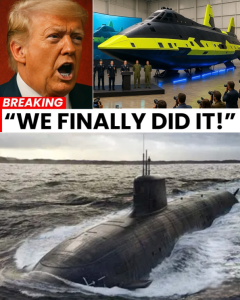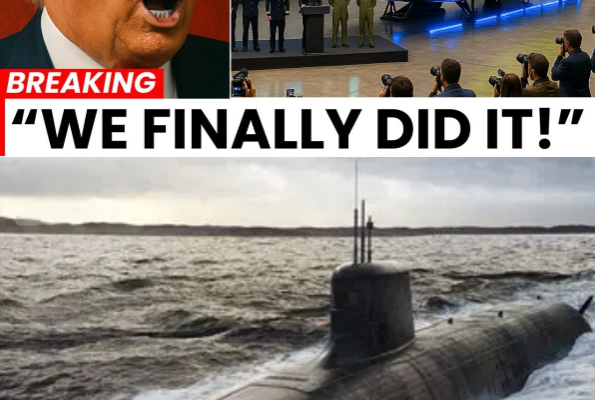💥 What Lurks Below: Inside the Secret Weapon That’s Making Every Navy on Earth Panic 😱
The world’s oceans have always been a stage for hidden power. Beneath the rolling waves, silent weapons shape the balance of military might. In the 21st century, that quiet battlefield has entered a new, terrifying chapter. A secret naval weapon—silent, swift, and deadly—is sending shockwaves through the world’s most powerful fleets. Governments are scrambling, admirals are on edge, and nations are rethinking their entire naval strategies. What could cause such panic? The answer lies deep below the surface.
🌊 The New Phantom of the Deep
For decades, submarines have been the ultimate stealth weapons. But today, something even more advanced has emerged—a new generation of autonomous underwater vehicles (AUVs). These are not the slow, limited drones of the past. They are fast, quiet, AI-driven hunter-killers capable of operating without human crews for months at a time.
One of the most talked-about developments in recent years comes from programs like Poseidon (Status-6), an unmanned nuclear-powered underwater drone reportedly developed by Russian Navy. Capable of crossing oceans undetected, it’s designed to carry massive payloads and move at speeds that challenge traditional anti-submarine defenses. But Russia isn’t alone. Multiple countries, including the United States and China, have poured resources into similar “ghost” platforms.
These underwater drones can operate at extreme depths where traditional sonar struggles to detect them. Even the most advanced ships may not realize a threat is nearby until it’s far too late.
⚔️ The Stealth Factor That Changes Everything
In modern naval warfare, detection is everything. If you can’t see the enemy, you can’t stop them. This is where these new underwater weapons excel. Traditional submarines rely on human crews, require resupply, and have a limited operational range. By contrast, AUVs can:
-
Operate for months without surfacing.
-
Move silently, using special propulsion systems that mimic natural sea currents.
-
Navigate complex terrain with AI that “learns” and adapts in real time.
-
Strike targets with conventional or nuclear payloads.
Imagine a weapon that doesn’t need a base, doesn’t need orders once launched, and can lurk undetected near an enemy coastline. That’s not just a new tool of war—it’s a strategic nightmare.
🧭 Global Powers in a Subsea Arms Race
The rise of these technologies has ignited a new kind of arms race.
-
The U.S. Navy is investing heavily in a network of smart undersea sensors and anti-drone defenses to detect and counter these “phantoms.”
-
The People’s Liberation Army Navy is believed to be developing its own long-range underwater drones designed to patrol the Pacific and Indian Oceans.
-
Smaller nations are also jumping in, seeing AUVs as a cheaper way to challenge traditional navies.
This technology levels the playing field. A small nation with a handful of stealth underwater drones could pose a real threat to even the largest fleets. Naval dominance no longer belongs only to countries with massive surface fleets—it’s slipping into the shadows beneath the sea.
🕵️ Why This Weapon Is So Terrifying
Unlike aircraft carriers or fighter jets, these underwater weapons can remain completely invisible until the moment they strike. They don’t need to fly over radar. They don’t leave a heat signature like missiles. They glide silently through the deep, waiting for a signal—or sometimes acting on pre-programmed missions.
One nightmare scenario for naval strategists is a “sleeper drone” strategy: an AUV could be deployed near a major harbor and lie dormant for weeks or months. Then, on command, it could launch a devastating attack on warships or critical infrastructure like undersea cables, ports, and energy pipelines.
This kind of threat isn’t science fiction. It’s already part of real-world war planning.
🧠 AI: The Brain Behind the Beast
What makes this weapon truly different from past naval technology is its brain. These drones are powered by advanced AI capable of autonomous decision-making. They can:
-
Avoid sonar nets.
-
Choose the most efficient route.
-
Hide in natural ocean noise to avoid detection.
-
Identify targets with pinpoint accuracy.
If they lose contact with their command center, they can still complete their mission. That makes them both powerful and unpredictable.
Some experts warn that if such AI systems are hacked or malfunction, they could act without human oversight—an uncontrolled predator beneath the sea.
🌐 The Ocean as the Next Warzone
For centuries, nations focused their military strategies on land and air. Now, the undersea world is taking center stage. Undersea communication cables carry more than 95% of global internet traffic. Offshore energy infrastructure powers economies. Shipping lanes are lifelines for trade. And under the waves, fleets of stealthy, autonomous drones are prowling.
This creates a dangerous reality: the next major conflict might not begin with a missile strike or a cyberattack, but with something nobody can see—an underwater weapon severing communications, sinking ships, or triggering chaos at critical chokepoints.
🚨 Global Response and the Shadow War
Navies around the world are responding in silence. While they rarely admit it publicly, military analysts believe that dozens of underwater encounters have already happened—near misses between drones and submarines that the public never hears about.
New strategies are being developed:
-
Massive networks of undersea listening devices.
-
AI-powered sonar that can distinguish between whales and war machines.
-
Underwater hunter drones designed to track and neutralize enemy AUVs.
But here’s the problem: the ocean is vast. No amount of technology can perfectly monitor every trench, canyon, or continental shelf.
🧊 A Dangerous Future
The emergence of these underwater weapons represents a turning point in naval history. Just as nuclear weapons changed geopolitics in the 20th century, autonomous underwater drones may shape the 21st. They are cheaper than aircraft carriers, harder to detect than missiles, and capable of striking without warning.
What makes them especially alarming is how accessible the technology is becoming. While the most advanced systems belong to superpowers, even smaller nations or non-state actors could eventually deploy similar tools. That introduces uncertainty—and uncertainty breeds fear.
⚠️ Final Thoughts: Power in the Shadows
The secret weapon lurking beneath the sea isn’t just a machine. It’s a shift in how wars can be fought. When the enemy can strike without being seen, traditional military power becomes vulnerable. Every navy on Earth is feeling that vulnerability now.
The silent battlefield of the deep is expanding. Ghostly underwater drones glide unseen beneath the waves, rewriting the rules of warfare. They don’t need a flag, a base, or a warning shot. Their power lies in the shadows—where panic spreads not because of what’s known, but because of what can’t be seen.
The question isn’t if these underwater weapons will change global security. They already have.
And somewhere, deep below the surface, they’re waiting.


